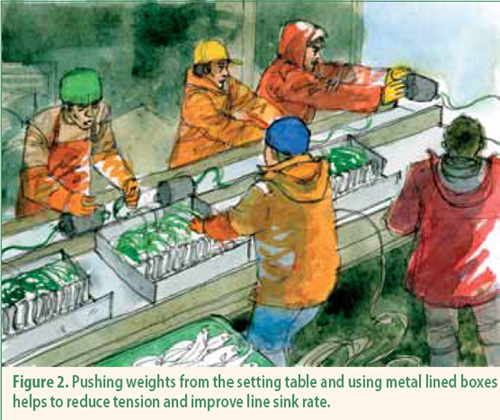The Eighth Session of the Scientific Committee (WCPFC-SC8) of the Western and Central Pacific Fisheries Commission (WCPFC) was held in Busan, Korea over 7-15 August 2012. Warren Papworth, ACAP Executive Secretary, represented the Agreement at the meeting. ACAP submitted three papers for consideration (see below).
At the Scientific Committee meeting ACAP sought endorsement of best-practice advice for seabird bycatch mitigation measures in pelagic longline fisheries. It is considered that a combination of weighted branch lines, bird-scaring lines and night setting is the most effective means of minimising seabird bycatch in high-risk areas.
Following the review of the papers presented, the SC determined that currently there is no single mitigation measure that can reliably prevent the incidental mortality of seabirds in most pelagic longline fisheries and recognized the advice from ACAP that the above three mitigation measures are indeed the most effective.
The Scientific Committee reiterated advice that a spatial management approach be employed for seabird mitigation and recommended that the Commission when revising CMM-2007-04 (Conservation and Management Measure to Mitigate the Impact of Fishing for Highly Migratory Fish Stocks on Seabirds) requires southern-hemisphere fisheries south of 30°S to use at least two of the three measures.
ACAP noted that its seabird identification guide is still in the draft phase and requested feedback as it would like to produce a guide that is useful and reliable for all the tuna RFMOs.
The Ninth Regular Session of the Commission will be held in Manila, The Philippines over 3-7 December 2012 (click here). ACAP plans to be represented at this meeting and hopes that the Scientific Committee's recommendations on mitigation measures will then be adopted.

Selected meeting papers:
ACAP 2012. Review of seabird bycatch mitigation measures for pelagic longline fisheries. WCPFC-SC8-2012/EB-WP-06. 20 pp.
ACAP 2012. Minimum data requirements for monitoring seabird bycatch. WCPFC-SC8-2012/B-WP-07. 17 pp.
Beck, N., Inoue, Y. & Papworth, W. 2012. Progress report on the development of a seabird identification guide for use by tRFMOs. Rev. 2 (31 July 2012). WCPFC-SC8-2012/EB-IP-04. 11 pp.
Fitzsimmons, L. 2012. Bycatch mitigation information system. WCPFC-SC8-2012/EB-IP-01.
Robertson, R. & Hay, I. 2012. Progress report on the development and testing of the underwater bait setter for pelagic longline fisheries. WCPFC-SC8-2012/EB-IP-02. 5 pp.
Robertson, G., Candy, S.G. & Hall, S. 2012. New branch line weighting regimes reduce risk of seabird mortality in the Australian pelagic longline fishery without affecting fish catch. WCPFC-SC8-EB-WP-09. 19 pp.
Robertson, G, Candy, S.G. & Hay I. 2012. Branch line weighting options that reduce the risk of seabird bycatch. WCPFC-SC8-2012/EB-WP-10. 12 pp.
Click here to download the above meeting papers.
John Cooper, ACAP Information Officer, 29 August 2012

 English
English  Français
Français  Español
Español